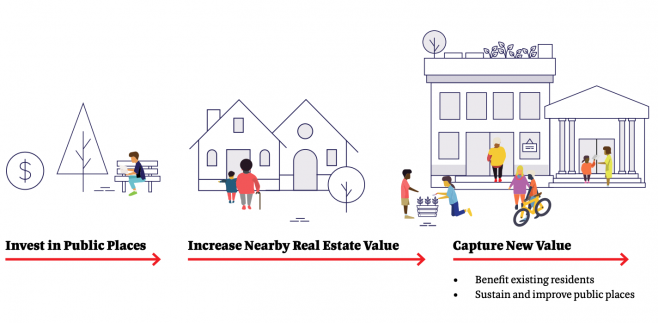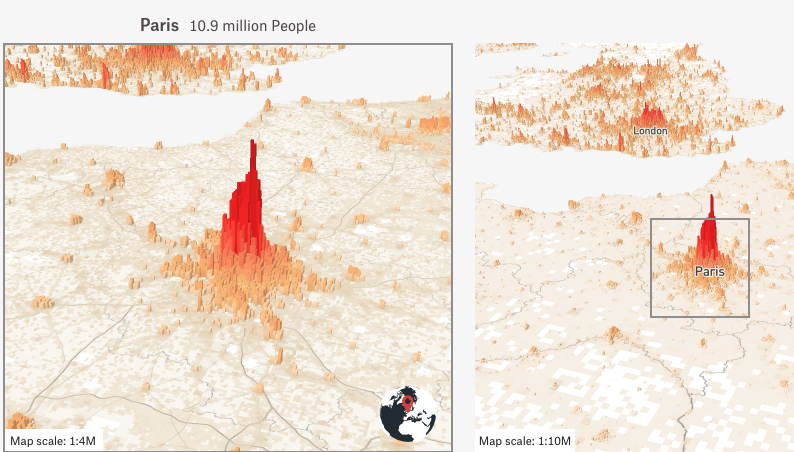What City Observatory did this week
1. Cities, Ideas and Us: Paul Romer’s Nobel Address. Romer, who won this year’s Nobel Prize in the Economic Sciences had some interesting things to say about cities in his address to the Royal Swedish Academy this past weekend. A key insight of his work is the observation that ideas are “non-rival” that they can be widely shared without diminishing their usefulness to any individual. That particular property of ideas both underpins the optimistic prospects for long term economic growth, but also highlights the importance of, in Romer’s words “expanding the circle of us.” Unlike a Malthusian world of fixed physical resources, the non-rival character of ideas implies that we’re better off when more of us or contributing our energy and imaginations to creating more. That dynamic underlies the reason for cities: we’re better off in places where there are lots of other people contributing their ideas and talents to the economy.
2. Consuming place: restaurants per capita. We offer up one indicator of how different metropolitan area’s stack up in terms of eating options, our computation and ranking of the number of restaurants per capita. Cities are not just places of production, they’re importantly places of consumption as well, and one of the most important forms of consumption is eating. We’ve tabulated the latest data from the Census Bureau, and ranked the nation’s largest metros from those with the most restaurants per capita (San Francisco) to those with the least (Riverside). See how your city stacks up.
3. A value capture toolkit. Civic assets like parks, libraries and community centers typically add value to the neighborhoods in which they are located, but also tend to struggle to find the resources to maintain or improve themselves. A new toolkit from U3 and the project Reinvigorating the Civic Commons outlines a set of policies and programs that neighborhoods and cities can use to tap at least some of the value created by these civic assets to help support their functioning, and to expand the benefits of a robust civic commons.
Must read
1. A practical response to gentrification: build more housing. The New York Times reports on the efforts of Brooklyn pastor A. R. Bernard to build several thousand units of affordable housing as a way for low and moderate income residents of his neighborhood to continue to afford to live there as property values rise. Bernard is proposing to turn his Brooklyn church’s parking lot into an urban village with shops, community space and about 2,100 apartments. Rather than simply objecting to new development, or hoping that things won’t change, this approach holds some promise of fighting displacement in a way that enables a community to be home to people from a wide range of incomes.
2. Why do conservatives hate cities? The National Review’s Kevin Williamson has an interesting column asking why conservatives seem to take such great glee is denigrating the nation’s cities. As the red/blue divide has intensified, it’s become increasingly common to heap scorn on anything that happens in urban areas. It’s an increasingly urban-dominated world, it’s not likely to be a winning strategy in the long term.
And there are still millions of Americans who want to advance and to enjoy the best things that American life has to offer, many (though by no means all) of which are to be found in the greatest abundance in American cities and in the cosmopolitan culture that America conservatives once took for granted as something of their own. What do we have to offer them? When is the last time we asked them what it is they like about Brooklyn and Austin? When is the last time we considered their personal and cultural aspirations with anything other than resentment, contempt, and outrage?
3. 3-D visualizations of urban density. Matt Daniels has a web-based exposition on population mountains that offers some compelling 3-D images of urban density around the world. They illustrate the spikiness of population. Here are two views of Paris, one focused on the Ile de France, and the other pulled back to show Paris in relation to London and Southern England.
New Knowledge
Gas prices and road deaths. A new study from New Zealand explores the statistical correlation between gasoline prices and road deaths. Lower gas prices prompt more driving, which in turn leads to more crashes, injuries and deaths. The study by Australian economists Rohan Best and Paul Burke looks at three decades worth of data for New Zealand. They find a negative relationship between fuel prices as crash deaths: a 1 percent decrease in fuel prices is associated with a 0.2 to 0.8 percent increase in deaths. They conclude that declining fuel prices probably explain about half of the increase in road deaths in New Zealand in the past few years:
How large a contribution did lower fuel prices make to the increase in New Zealand’s road death toll since 2013? The real retail fuel price decreased by approximately 23% from 2013 to 2016. If one were to apply the average fuel price elasticity of road deaths over the period May 2004–March 2017 (Table 5), this would be associated with an increase in the level of road deaths of approximately 16%. It is thus conceivable that around half of the overall increase in road deaths over the period was due to lower fuel prices.
Rohan Best & Paul J. Burke, Fuel prices and road accident outcomes in New Zealand, CAMA Working Paper 57/2018, November 2018.
In the News
City Observatory’s Joe Cortright testified to a Washington legislative committee looking at reviving the ill-fated $3 billion Columbia River Crossing project, warning them not to repeat the mistakes that caused the project to implode 5 years ago, after wasting $200 million on planning–via OPB News.




